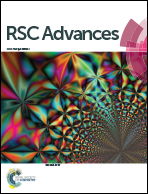Fluorographene nanosheets: a new carbon-based matrix for the detection of small molecules by MALDI-TOF MS†
Abstract
Fluorographene nanosheets (FG) were synthesized via one-pot chloroform-mediated sonochemical exfoliation under ambient conditions. For the first time, this material served as a novel matrix for the detection of small molecules by negative ion MALDI-TOF MS. The structural characterization and ionization mechanism of FG were illustrated. The unique properties of FG endow it with properties such as low background, excellent chemical compatibility and homogeneity over conventional carbon based matrices. Most significantly, application of FG as matrix resolved the contamination problem of conventional carbon based matrices to ion source. With the association of FG, a variety of small molecules containing amino acids, peptides, small metabolites, drugs and organonitrogen compounds were analyzed. The developed method was found to have excellent feasibility with biosystems. Based on this, qualitative analysis of sialic acid in human saliva, melatonin in human urine and in situ analysis of MCF-7 cells were done, besides, quantification of anti-cancer drug in human serum and uric acid in human urine were displayed. This work extends the application fields of FG and provides a good candidate of matrix for MALDI-TOF MS detection of small molecules.


 Please wait while we load your content...
Please wait while we load your content...